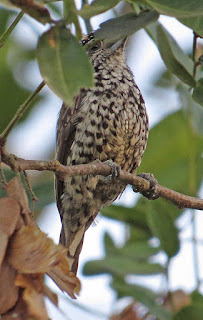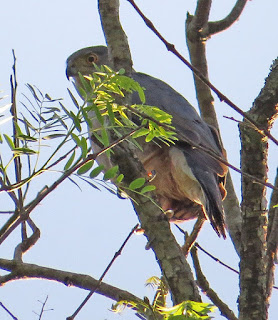September
16, 2015
Today we
arrived at Refugio Los Volcanes, one of the most picturesque birding lodge
settings in the world. When you arrive at the top of the drive, this is what
you see. The lodge is in the valley below, and it really looks like this and
feels even more remote and peaceful.
But I’m
getting a bit ahead of myself; we did get some birding in today, despite its
being largely a travel day. In particular we started right behind our hotel in
Camiri, where just-arrived (or perhaps still southbound) Southern Martins and
Tawny-headed Swallows were a highlight. Always puzzling in this region are the
piculets, where the presumed species Ocellated (Andean), White-wedged
(Brazilian and Bolivian dry woodland), and White-barred (Chaco) all meet. The
exact pattern of the feathers on the breast is clearly different if you look at
individuals from the distant corners of their distributions, but in this region
where they all meet, I’m never quite certain if I’m looking at so-called
ocelli, bars, or wedges. Their voices are probably identical, and it may be
eventually shown that central Bolivia is home to a hybrid swarm and that
they’re all one species. Or maybe there are very narrow hybrid zones with steep
clines in genetic and morphological differences. But for the time being,
despite our being out of the immediate Andean foothills and theoretically in
the Chaco, I’m calling this one an Ocellated Piculet.
Our major
birding stop this morning was at some small lakes in Ipati (not to be confused
with the town just to the north named Ipitá). There were lots of goodies,
including Brazilian Teal, Solitary Sandpiper, and White-winged Coot with
juveniles (so they apparently bred here). The huge mesquites here were draped
in a rope-like epiphytic cactus, Lepismium
lumbricoides.
These Polistes sp. wasps built their nests in
loose colonies on the undersides of the mesquite limbs. We had seen hundreds of
these nests on the cliffs north of Lagunillas yesterday.
We completed
the long drive in time to take two hours to walk the very steep 3-kilometer
entrance driveway into Refugio Los Volcanes. We actually saw a Short-tailed
Antthrush (usually a heard-only bird), but this rare Bicolored Hawk (the
widespread but rare tropical version of the Cooper’s Hawk) was undoubtedly the
highlight of the walk.










No comments:
Post a Comment